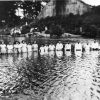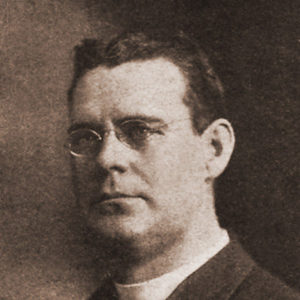calsfoundation@cals.org
Thomas J. Hagerty (1862–?)
Thomas J. Hagerty was a Roman Catholic priest and social activist. He was originally involved in the Socialist Party of America (SPA), an association that included some early interactions with the active Arkansas chapter of the party. However, he eventually left the socialists and embraced the revolutionary syndicalism of the Industrial Workers of the World (IWW), an organization he helped to establish.
Thomas Hagerty was born in 1862, but there is little information about his life prior to his ordination in Chicago, Illinois, in 1895. While there were rumors that he was a socialist prior to his ordination, his politics became problematic for the church soon after he entered the priesthood. He was transferred to the Archdiocese of Dallas, Texas, and assigned to serve in Paris, Texas, apparently in the belief that he could not cause trouble there. In fact, life in Texas served to radicalize the young priest further, as he was outraged at the mistreatment he saw inflicted on Mexican railroad workers there. In response, Hagerty translated socialist tracts into Spanish and distributed them to the workers. The local railroad bosses, not happy with his efforts, hired people to intimidate him, but the priest did not retreat. In fact, he told the “goons” who came to see him that he had a set of guns and was prepared to use them.
In 1902, he moved to Van Buren (Crawford County). There, he spent considerable time preaching socialist doctrine to the miners of Sebastian County, trying to convince the Irish union leaders, as well as the newer Catholic immigrants, that socialism and Catholicism were compatible. He also gave a well-attended lecture in Little Rock (Pulaski County) that offered listeners an impressive overview of the nation’s industrial problems. During this period, as the socialist movement was growing in Arkansas under the leadership of Dan Hogan, Hagerty would often visit Huntington (Sebastian County) to talk with Hogan.
Despite his active and early involvement with the socialist movement, by the middle of the first decade of the twentieth century, Hagerty had become disenchanted. Frustrated by ineffectual efforts, he came to disdain socialist politics, at one point declaring that the ballot box was simply a “capitalist concession,” adding that “dropping pieces of paper into a hole in a box never did achieve emancipation of the working class and in my opinion it never will.” He dismissively referred to his politically oriented reform partners as “slowcialists.” Looking for more effective avenues for change, Hagerty turned to what one author termed “revolutionary syndicalism,” the idea that workers should employ direct action rather than the ballot box in order to gain control over the means of production. Addressing miners at Telluride, Colorado, in 1902, he proclaimed, “The railroad is yours; those large businesses blocks and office buildings downtown that bring in big rent are yours; if you want them, go take them.” He urged the workers to confiscate the property.
This continued activism outside the church led, in 1903, to a transfer to Our Lady of Sorrows Church in Las Vegas, New Mexico. He also served as the editor and primary writer for The Voice of Labor, the official newspaper of the American Labor Union, a short-lived but active organization.
Hagerty’s sentiments ultimately led him to help establish the Industrial Workers of the World (IWW). He was one of the original six individuals who, meeting in the fall of 1904, sent out invitations to leading labor radicals in an effort to found a militant union. That effort led to the June 1905 conference in Chicago, where the IWW was founded, with Hagerty very much at the center. He served as the secretary of the constitution committee, helping to write the union’s manifesto. He has been credited as the author of the first draft of the preamble to the IWW Constitution, a declaration whose radical message was ultimately toned down, making it more acceptable to the socialists, whose support other leaders sought to retain. Hagerty also designed what Samuel Gompers, leader of the American Federation of Labor, derisively labeled “Hagerty’s Wheel of Fortune,” a graphic depiction of the various trade unions and their relationships both to each other and to their role as representatives of the working class. While most delegates to the convention did not fully understand its meaning, Hagerty apparently saw it as offering a structure for the organization.
Despite his central involvement with its founding exercises, soon after the IWW began operations, Hagerty seemed to fade from the public stage. There were reports that he returned to Chicago, where he taught Spanish to support himself, but the details of the rest of his life are unknown.
For additional information:
Boer, Roland, “Father Thomas J. Hagerty: A Forgotten Religious Communist.” MRZine, February 14, 2011. http://mrzine.monthlyreview.org/2011/boer140211.html (accessed September 10, 2020).
Doherty, Robert E. “Thomas J. Hagerty, the Church, and Socialism.” Labor History 3 (1963): 39–56.
“The Early IWW, the Preamble and the Break with Political Socialism.” Libcom.org. http://libcom.org/library/early-iww-preamble-break-political-socialism (accessed September 10, 2020).
“‘Father’ Thomas J. Haggerty.” Industrial Workers of the World, October 26, 2011. http://www.iww.org/it/history/biography/FatherHaggerty (accessed September 10, 2020).
“Father Thomas J. Haggerty’s Wheel.” Industrial Workers of the World. http://www.iww.org/about/official/wheel (accessed September 10, 2020).
Kiser, G. Gregory. “The Socialist Party in Arkansas, 1900–1912.” Arkansas Historical Quarterly 40 (Summer 1981): 119–153.
William H. Pruden III
Ravenscroft School
 Civil Rights and Social Change
Civil Rights and Social Change Early Twentieth Century, 1901 through 1940
Early Twentieth Century, 1901 through 1940 Religion
Religion Thomas J. Hagerty
Thomas J. Hagerty 




Comments
No comments on this entry yet.